|
|
Hypothermia
is a very serious condition in which the temperature of the body core drops to
below 35 degrees Celsius. This cooling, if not checked, can lead to
disorientation, unconsciousness and death. (More
about hypothermia).
Prior
to the 1960s, the popular wisdom was that drowning was the cause of death in
cases where people were lost overboard, especially in temperate latitudes.
However, in the 1960s and 1970s attention began to shift to hypothermia as a
major cause of death in instances of cold water immersion.
Since cold water will carry heat away from the body 25 times
faster than air of the same temperature, the average body cools rapidly,
and within 20 to 30 minutes, depending on water temperature, body core
temperature drops to below 35 degrees C (95 degrees F.) An individual's
response to cold water will vary from the average depending on a number of
factors including clothing, amount of body fat, activity, etc. but the
steady decline in core temperature will continue until the person is
removed from the water.
One can extend survival time by simply elevating a
portion of the body out of the water onto floating wreckage. Every square
inch of body surface removed from the water will incrementally extend the
cooling time, even though the air feels cool and a wind may be
blowing.
|
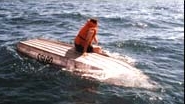
|
|
Once
popular attention was focused on hypothermia, products appeared that would
protect a person from the effects of hypothermia, and greatly extend survival
times. These thermal protection products fell into
three broad categories. These and other technologies have significantly
improved the survival odds in ship abandonment situations.
In
recent years, due to the pioneering work of Drs. Michael Tipton and Frank Golden
(UK) and in Canada, Dr. Chris Brooks, it has become clear that hypothermia may
not be the major cause of death in cold water immersion situations. It appears
that up to 60% of the fatalities due to cold water immersion occur in the first
15 minutes (up to 75% in Alaska), long before the body core cools to hypothermic
levels.
|
|
In
the UK in 1977, 55% of open water drownings occurred within 3 meters of safety
and 42% occurred within 2 meters. (United Kingdom Home
Office)
In Canada,
between 1991 and 2000, 41%
of those who were boating and drowned were within 10 meters of shore. An
additional 22% were within 10 to 15 meters of shore.
(Canadian
Safe Boating Council / SmartRisk Study)
Clearly
some mechanism is at work that prevents people from being able to help
themselves. These effects are cold shock and swimming failure. Physiological
responses in the skin and in the muscles of the arms and legs, combined with
psychological responses, can swiftly lead to drowning. For more information on
this subject, refer to:
Transport
Canada Publication TP13822, Survival in Cold Water
|

Illustration
by Sir John Tenniel from Alice in Wonderland |
|
Coroners
and pathologists are only now becoming aware of these mechanisms for drowning in
cold water. Until recently, most deaths were attributed to hypothermia simply
because victims' bodies were wet and cold. Now we now that there are signs which
will indicate whether the victim died from drowning due to cold water shock or
from hypothermia.
Lessons
Learned
The
lesson is really very simple. It is not enough to carry a Personal
Flotation Device (PFD) on your boat. Once in the water you may not be able
to swim the two or three meters necessary to find it. And once you have
reached it, you may not have the dexterity to put it on.
The
only effective prevention is to wear a PFD or lifejacket at all times
there is a risk of falling overboard or being ejected from a small boat.
Once you have entered the water it is too late--the physiological and
neurological responses of your body to the sudden cold may make it
impossible for you to keep your airway above water, and you may drown.
|
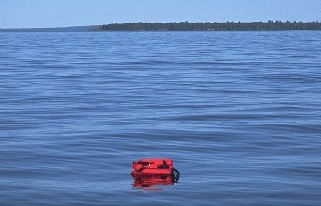
|
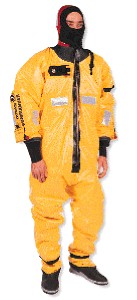 |
Immersion
suits
These
suits were designed to keep the wearer dry with watertight face and wrist
seals. The boots are integral with the suit. Made of neoprene rubber and
other impervious materials, these suits provided both flotation and
insulation, and immediately began to save lives. It wasn't very long
before they became mandatory in a number of marine industries such as the
British Columbia fishing industry. Modern survival suits are rugged, easy
to don, and will extend survival time to an extraordinary degree if they
are put on when one is dry. |
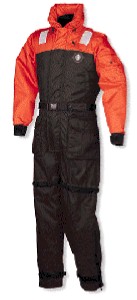 |
Thermal
protective coveralls (anti-exposure suit)
These
coveralls are designed to be worn while working . They provide protection
from cold air temperature, and when immersed, provide insulation and
flotation. However, they are not watertight and will fill with water in a
relatively short time. This water is warmed by the body core and is retained
within the suit, providing significant insulation value, and thus
extending survival time.
These
floatation devices are designed to assist in retaining body heat
through thermal protection of the body’s high heat loss areas (head,
neck, armpits, sides of chest and groin). |
|
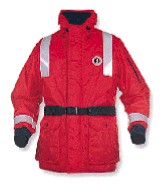
|
Thermal
system coat
This
type of coat provides insulation and flotation. Some have a
"beavertail"--a neoprene rubber flap that can be pulled down
from the back of the jacket, under the crotch, and secures to the front of
the jacket. When immersed, one deploys the beavertail and secures it to
the front of the coat. This provides a surprisingly effective barrier to
the movement of water in and out of the coat, effectively trapping a layer
of warm water against the body. However, the high-heat loss areas of the
upper thighs are still exposed to the cooling effects of the water. |
 |
Personal
Flotation Devices
Though
a Personal Flotation Device has little insulation value, it will help you
keep your airway above water and prevent drowning. Drowning due to sudden
cold water immersion is the most common cause of death for recreational
boaters in Canada. |
|
|